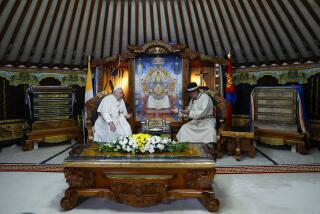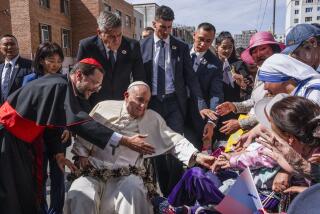John Paul First Pope to Visit Mosque
- Share via
DAMASCUS, Syria — Urging interfaith partnership “for the good of the human family,” Pope John Paul II shuffled slowly into the Great Omayyad Mosque here Sunday evening to become the first pontiff to visit and pray in a Muslim house of worship.
Syria’s grand mufti walked at John Paul’s side as the two octogenarians, leaning on canes, crossed a sensitive line in relations between the world’s two largest religions. The gesture was largely symbolic, and some Roman Catholic leaders cautioned that it would not bring an early end to centuries of hostility and mistrust.
But the two religious leaders, who first met at the Vatican 16 years ago, called it a promising first step.
“I am so happy you are here!” said the mufti, Sheik Ahmad Kuftaro, proclaiming “the start of a new era of tolerance” and “a great day for Muslims around the world.”
The Catholic leader replied: “This is an occasion that goes beyond history. It will help the cause of peace.” A crowd of Muslim clerics applauded as he left the mosque.
Kuftaro later used the occasion to condemn Israeli “atrocities and oppression” and to echo Syrian President Bashar Assad’s insistence Saturday that his holy guest side unequivocally with Arabs in the Middle East conflict.
But Syria’s posturing in the papal limelight, which prompted a rebuke from Israel’s president Sunday, failed to elicit a partisan stand by the pope or overshadow his historic visit to the mosque. Muslim clerics mobbed John Paul as he entered--some presented him with prayer beads--and applauded him as he left.
Interfaith healing became an official part of Catholic teaching in 1965, but the Polish pontiff has done more in his 22 1/2-year reign than any modern predecessor to promote dialogue with other religions.
In 1986 in Rome, he became the first pope to enter a Jewish synagogue, and last year he made the first papal visit to Israel, sealing his legacy as a crusader against anti-Semitism. In Athens on Friday, he voiced regret for all sins committed by Catholics against Orthodox believers, aiming to heal a millennium-old schism between the two branches of Christianity.
In Syria, the second stop of a three-country pilgrimage, he is trying to give new life to a halting dialogue between the Vatican and Muslim leaders that began in earnest 25 years ago.
Speaking as he emerged from the mosque into its vast, white-marble courtyard, the 80-year-old pope urged a crowd of Muslim and Catholic clerics and scholars to “present our two great religious communities as communities in respectful dialogue, never more as communities in conflict.”
“It is crucial for the young to be taught the ways of respect and understanding,” he added, “so that they will not be led to misuse religion itself to promote or justify hatred and violence.”
The turban-clad mufti, who is five years the pope’s senior, said in turn: “There must be fruitful meetings between us so that we can strive together to support the oppressed and the needy.”
Catholicism and Islam count slightly more than 1 billion followers each. They share a belief in one God, some common prophets and, as John Paul noted in his speech, a “silent respect for each other’s prayer” in most places where their followers coexist.
But they differ on theological issues such as the divinity of Christ and have been fighting since the Crusades over territory and spiritual primacy. Catholic-Muslim hostility has fed recent ethnic wars in Sudan, Indonesia, Bosnia-Herzegovina and Lebanon, and it has helped stiffen Christian-dominated Europe’s resistance to Muslim immigrants from Africa and Asia.
John Paul began his high-profile outreach toward Islam with a 1985 speech to 80,000 young Muslims in Morocco. The next year, he brought Muslim leaders to a gathering of all the major religions in Assisi, Italy. He seeks out Muslim leaders nearly everywhere he travels.
But these efforts have met with resistance among some Muslim theologians and also within the Vatican. As a result, formal interfaith discussions promoted by the pope and progressive Islamic leaders rarely go beyond platitudes to frank exchanges on serious differences.
Such discussions between Catholics and Jews, on such sensitive issues as Catholic complicity in the Holocaust, are considerably more advanced. For that reason, some Catholic officials cautioned against reading too much into John Paul’s visit to the mosque.
“It’s a major event, but it cannot be compared to his visit to the synagogue,” said Cardinal Jean-Marie Lustiger, who was born a Jew in Poland but converted to Catholicism after World War II and is now archbishop of Paris. “What happened today is courteous dialogue but not, as it was at the synagogue, [part of] a joint reexamination of a tragic history.”
Yet it was a start. Despite the Prophet Muhammad’s appeal for people of different faiths to enter each other’s houses of worship, no modern pope had ever proposed or been invited to enter a mosque, Vatican officials said.
“We had not been invited before and we didn’t want to offend anyone by asking,” said Cardinal Roberto Tucci, the pope’s advance man.
The pope is following St. Paul’s footsteps through Greece, Syria and Malta. Meeting with Syrian officials earlier this year, Tucci said he was told that no visit to Damascus would be complete without a visit to its 1,300-year-old Omayyad mosque in the walled Old City.
“The Syrians were open to such a visit, so I went to the pope and asked whether he had a problem with that, and he said no,” the cardinal added.
The mosque was built in 705 on a site that was once used for pagan sacrifice in honor of the Roman god Jupiter and that later became a Christian basilica. After Muslim Arabs captured the city in 636, it was converted to a mosque, with a central shrine to John the Baptist, who is revered by both faiths. A courtyard contains the tomb of Salladin, the Muslim warrior who reconquered Jerusalem from Catholic Crusaders.
The pope, two cardinals and a few aides entered the mosque after respectfully removing their shoes and donning cloth slippers. John Paul stumbled slightly once at the threshold and again while crossing the carpeted floor of the vast, white-columned house of worship.
As the pope approached a tomb believed to contain the head of John the Baptist, an English-speaking aide to the mufti told the pontiff: “Now we will leave you alone with God so that you can pray.”
The pope bowed his head for a minute while his lips moved silently. In deference to Muslim sensitivities, he said no formal prayer inside the mosque.
Afterward, in the courtyard outside, the pope and the mufti shook hands and addressed the issue of historic grievances between their flocks.
“For all the times that Muslims and Christians have offended one another, we need to seek forgiveness,” the pope said.
The mufti added: “We should not linger over past mistakes by those who alleged they followed the teaching of their religion.”
What is more important, he said, is for the Vatican to “stand in support of justice and put pressure on Israel by every means to curb its atrocious aggression. . . . This is the least that Christianity, as a proof of its allegiance to Jesus Christ, can offer the world.”
Assad made a similar appeal when he welcomed the pope, claiming that Israelis were persecuting the Arabs as the Jews persecuted Jesus. On Sunday, Israeli President Moshe Katzav denounced the Syrian leader as racist and anti-Semitic and urged the Vatican to respond.
But Vatican spokesman Joaquin Navarro-Valls said the pope would not do so in Syria because “we are guests of this president.” He noted that John Paul has spoken out repeatedly against anti-Semitism.
More to Read
Sign up for Essential California
The most important California stories and recommendations in your inbox every morning.
You may occasionally receive promotional content from the Los Angeles Times.










